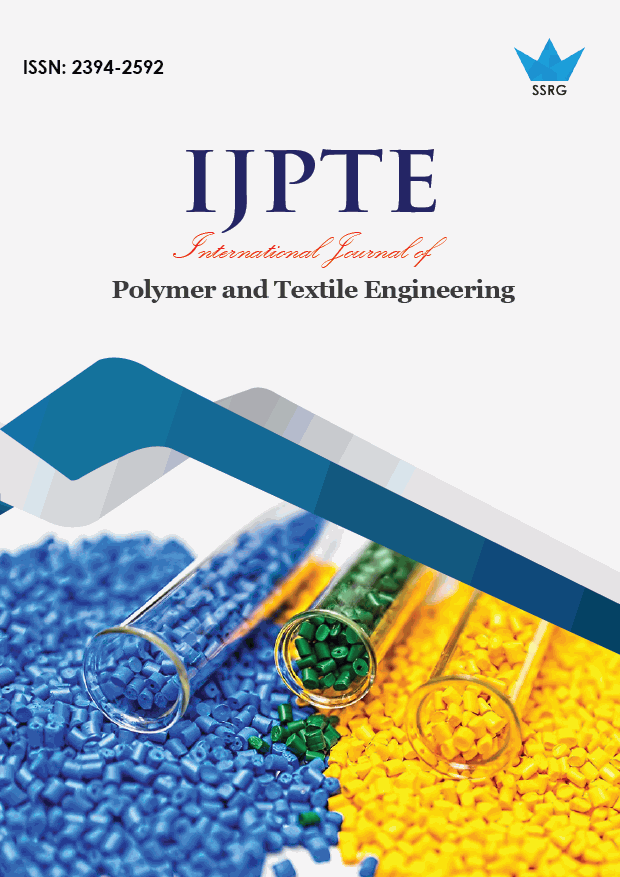Numerical Analysis of the Optimal Conditions of the Selected Tests for Bending Rigidity of Textiles

| International Journal of Polymer and Textile Engineering |
| © 2021 by SSRG - IJPTE Journal |
| Volume 8 Issue 1 |
| Year of Publication : 2021 |
| Authors : Szablewski, P. |
How to Cite?
Szablewski, P., "Numerical Analysis of the Optimal Conditions of the Selected Tests for Bending Rigidity of Textiles," SSRG International Journal of Polymer and Textile Engineering, vol. 8, no. 1, pp. 1-5, 2021. Crossref, https://doi.org/10.14445/23942592/IJPTE-V8I1P101
Abstract:
This work concerns numerical analysis two tests for bending length proposed by Peirce. These tests are the alternative for traditional gravitational cantilever Peirce’s test. The applied mathematical model treats the textile product as elastic, which is subject to large deflections – the bending moment is proportional to the curvature of the bent axis. The optimal conditions of these tests were also considered in order to obtain the results of measurements most sensitive to changes of the input parameters. The results also show how long the specimen to measure the bending rigidity should be within a certain range of values.
Keywords:
textile mechanics, fabrics, elastic, bending length, bending rigidity, numerical methods.
References:
[1] T.K. Ghosh and N. Zhou, Characterization of fabric bending behavior: A review of measurement principles, Indian Journal of Fibre & Textile Research. 28(4)(2003) 471–476.
[2] S. Sengupta, S. Debnath, and A. Sengupta, Fabric bending behavior testing instrument for technical textiles, Measurement: Journal of the International Measurement Confederation. 87(2016) 205–215.
[3] K. Ancutiene, E. Strazdiene, and A. Nesterova, The relationship between fabrics bending rigidity parameters defined by KES-F and FAST equipment, Medziagotyra, 16(4)(2010) 346–352.
[4] T.J. Lahey and G.R. Heppler, Mechanical Modeling of Fabrics in Bending, Journal of Applied Mechanics. 71(1)(2004) 32–40.
[5] M. Kocik, W. Zurek, I. Krucinska, J. Gersak, and J. Jakubczyk, Evaluating the bending rigidity of flat textiles with the use of an Instron tensile tester, FIBRES & TEXTILES in Eastern Europe. 13(2)(2005) 31–34.
[6] R.G. Livesey and J.D. Owen, Journal of the Textile Institute Transactions. 55(10)(1964) 516–530.
[7] T. Eeg-Olofsson, 7–Some Mechanical Properties of Viscose Rayon Fabrics, Journal of the Textile Institute Transactions. 50(1)(1959) T112–T132.
[8] T. Isshi, Bending Tester for Fibers, Yarns and Fabrics, Journal of the Textile Machinery Society of Japan. 3(2)(1957) 48–52.
[9] N. Zhou and T.K. Ghosh, On line
measurement of fabric bending
behavior: background, needs, and potential solutions, International Journal of Clothing Science and Technology. 10(2) (1998) 143–156.
[10] F.T. Peirce, The ‘Handle’ of Cloth As a Measurable Quantity, Journal of the Textile Institute Transactions. 21(9)(1930)
T377–T416.
[11] British Standard Institution, BS3356:1990 Determination of bending length and flexural rigidity of fabrics. 1(1990).
[12] European Committee for Standardization, Textiles - Test methods for nonwovens - Part 7: Determination of bending length (ISO 9073-7:1995) (1998).
[13] M.N. Sun, A New Tester and Method for Measuring Fabric Stiffness and Drape, Textile Research Journal. 78(9)(2008)
761–770.
[14] A. De Boos and David Tester, SiroFAST Fabric Assurance by Simple Testing. (1994).
[15] A. Staessen and K. Vanneste, Ontwerp en realisatie van een
programmeerbaar elektronisch meetplatform voor buigstijfheidsmetingen op textiel, Ghent University, master thesis. (2016).
[16] W. Żurek and K. Kopias, The Structure of Flat Textiles, WNT, Warsaw (1983) (in polish).
[17] T. Żyliński, Textile Metrology, WPLiS, Warsaw 2(1965) (in polish).

 10.14445/23942592/IJPTE-V8I1P101
10.14445/23942592/IJPTE-V8I1P101